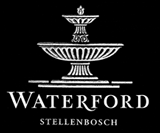De soortgelijkheid van wijn en glaswerk
 HvJ EG, 7 mei 2009, zaak C-398/07 P, Waterford Wedgwood plc, tegen OHIM (Nederlandse vertaling nog niet beschikbaar).
HvJ EG, 7 mei 2009, zaak C-398/07 P, Waterford Wedgwood plc, tegen OHIM (Nederlandse vertaling nog niet beschikbaar).
Gemeenschapsmerkenrecht Oppositieprocedure ingesteld tegen beeldmerkaanvrage Waterford Stellenbosch (klasse 33, ‘met name wijnen geproduceerd in de Stellenbosch streek, Zuid-Afrika’) middels woordmerk WATERFORD (klasse 21 ‘Glaswerk, aardewerk, porseleinen servies(goed) en porselein’).
Het Gerecht van Eerste Aanleg oordeelde eerder (IEF 4211) dat glaswerk en wijn niet soortgelijk zijn en het Hof bevestigt dit oordeel. Ook een sterk onderscheidende vermogen kan een ‘complete lack of similarity’ niet compenseren.
33. It follows that there may be a likelihood of confusion, notwithstanding a low degree of similarity between the trade marks, where the goods or services covered by them are very similar and the earlier mark is highly distinctive (see, to that effect, Canon, paragraph 19, and Lloyd Schuhfabrik Meyer, paragraph 21).
34. However, the interdependence of those different factors does not mean that the complete lack of similarity can be fully offset by the strong distinctive character of the earlier trade mark. For the purposes of applying Article 8(1)(b) of Regulation No 40/94, even where one trade mark is identical to another with a particularly high distinctive character, it is still necessary to adduce evidence of similarity between the goods or services covered. In contrast to Article 8(5) of Regulation No 40/94, which expressly refers to the situation in which the goods or services are not similar, Article 8(1)(b) of Regulation No 40/94 provides that the likelihood of confusion presupposes that the goods or services covered are identical or similar (see, by way of analogy, Canon, paragraph 22).
35. It must be noted that the Court of First Instance, in paragraphs 30 to 35 of the judgment under appeal, carried out a detailed assessment of the similarity of the goods in question on the basis of the factors mentioned in paragraph 23 of the judgment in Canon. However, it cannot be alleged that the Court of First Instance did not did not take into account the distinctiveness of the earlier trade mark when carrying out that assessment, since the strong reputation of that trade mark relied on by Waterford Wedgwood can only offset a low degree of similarity of goods for the purpose of assessing the likelihood of confusion, and cannot make up for the total absence of similarity. Since the Court of First Instance found, in paragraph 35 of the judgment under appeal, that the goods in question were not similar, one of the conditions necessary in order to establish a likelihood of confusion was lacking (see, to that effect, Canon, paragraph 22) and therefore, the Court of First Instance was right to hold that there was no such likelihood.
Lees het arrest hier.























































































